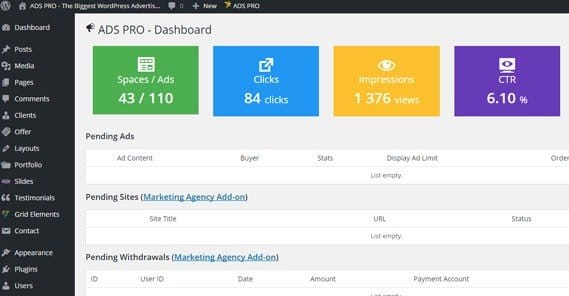7 Website Monetization Alternatives to Google AdSense

AdSense is one of the most common methods used to monetize a website, but it’s not necessarily the best option for you. There are a lot of reasons why it might not work out. One of the most prominent of those reasons is their strict terms of service, which can lead to your site being banned from AdSense entirely, either temporarily or permanently.
If you’re in a position where you’re not able to easily use AdSense, or you simply aren’t earning enough with it and want to try out an alternative monetization strategy, we’ve got you covered. I’ve put together a list of major alternative categories, different forms of monetization, along with a handful of recommended sites and networks you can use to implement them.
1. Direct AdSense PPC Alternatives
AdSense is a form of display advertising that works primarily through textual ad units and banner advertising. You’re paid generally per click, with rates measured per thousand clicks, so there’s not actually a ton of money flying around unless you’re working with thousands upon thousands of monthly views. That said, one of the ways you can make more money without going out of your way to boost your traffic is to change out your ad network. If AdSense is paying you 5 cents per click, and a different site is offering 8 cents per click, you can boost your earnings significantly just by changing over to that other network.
Adsterra is one such alternative, with a lot more robust forms of ad you can run. In addition to the standard text and banner display model, you can also use pop-unders – more on those later – and interstitials like the Forbes welcome screen. It also has ads that run in push-ups and sliders, like the Hello Bar or SumoMe shade.
Media.Net is another network very similar to AdSense. In fact, it’s the media network that gets you access to Bing and Yahoo contextual ads. They focus primarily on native advertising, or the “related posts” boxes, which show up on almost all sites these days. Whenever you see a related posts box that links to posts not on the site you’re on, it’s either Media.net, Taboola, or Outbrain, all of which are good options for that kind of advertising.
Chitika is another variation, and they have two primary types of ads. One relies on the search topic a user uses to find you. The other is for non-organic traffic, such as what you get by paying for ads or through sponsored content. Both work very well once you get them set up.
There are, of course, dozens of other options out there. I could practically write a list made up of lists of AdSense alternatives, but I’ll limit myself to one.
2. Self-Serve Ads
Ad networks are convenient, because they have code you put into place on your site and they handle the rest. They deal with rotating ads, they deal with serving the right ads to the right people, they deal with fill rates and tracking and all the rest.
The flip side to this is that they cost money for that service. Oh, you’re not paying them directly, no; the advertisers are the ones doing that. You’re just accepting a lower amount of money than the advertisers are paying. If the advertiser pays $1 per click, you might get 70 cents per click, or even less, with the ad network taking the rest. It’s a valid trade-off for the service rendered, but it isn’t entirely necessary.
If you prefer, and you have the time and/or coding skills necessary to pull it off, you can manage your ad space yourself. Nothing in the world says that you need to pay someone to manage everything on your site for you. It’s just generally the most convenient way.
Many businesses won’t want to deal with freelance publishers, unfortunately. Your selection will be more limited. However, that’s fine! All you need are a few dedicated advertisers willing to pay for ad space on your site. You can pitch yourself and negotiate your own rates, ideally higher than those found in ad networks.
One good source of self-serve advertising, a sort of middle ground between reaching out to advertisers yourself and running an ad network, is BuySellAds. Think of them like a self-serve ad network and you have the right idea.
3. Affiliate Marketing
Affiliate marketing is an entirely different form of online monetization. Rather than get paid when people click your link, you’re paid when people click your link and buy something from the destination site. See? Totally different.
Affiliate marketing has a few benefits over standard display advertising, however. In exchange for it being harder to achieve a conversion, you tend to get a higher payout – much higher in some cases. Where a single click that isn’t guaranteed to convert for the advertiser might be worth 10 cents to them, an actual product purchase may be worth $2.
Amazon’s affiliate program is by far the best in the business, for a few simple reasons. For one thing, they have a lot of tools to facilitate your sales, including analytics, shortlinks, widgets, and all of their own on-site advertising. Secondly, they’re Amazon. Who doesn’t know Amazon? Maybe some people don’t trust them, but they’re still the biggest name in online retail.
The best thing, however, is that they offer a commission on anything sold via your link, regardless of whether you linked to it or not. If I link to a $5 widget, and someone goes on and decides to buy a $1000 television, I get a commission on the television.
In addition to Amazon’s affiliate program, you can sign up with various individual affiliate networks, which grant you access to the products in those catalogs. They’re more restrictive than Amazon, but potentially easier sells, so it’s worth checking them out. I recommend CJ Affiliate, Rakuten, the eBay network, and MaxBounty to start.
4. Sell Digital Products
When push comes to shove, you don’t need to put all of your marketing prowess to use selling products for others if you don’t want to. You can also sell products for yourself. Digital products are great for this, whether you develop an app, write some software, or publish an ebook.
Ebooks are great for double-dipping as well. When you sell an ebook, you can sell it via Amazon, and use Amazon affiliate links to do it. You get a tiny commission on your own book in addition to the sale price, plus you get commissions on whatever else that user goes on to buy that session.
I like selling ebooks because they’re simple to produce. Find your top performing blog post and use it as an outline. Each section, expand into a chapter. Turn a 2,000-word blog post into a 10,000-word ebook. Add in graphics, add in links, add in references. Dig deeper into topics, gather more data, analyze it all deeper. All of this guarantees that you’ll produce a high quality ebook on the topic your audience is already proven interested in reading.
Regardless of the type of digital product you produce, you have to choose how to sell it. Ebooks, again, are great because you can sell them through Amazon. Other forms of digital product might need a self-serve storefront, using something like Shopify. You have a range of options, so determine what works best for you in terms of upkeep and security.
5. Sell Review and Guest Post Space
As a blogger, you can always monetize your blogging directly. Your blog has X number of visitors per month, and it’s about Y topic. That’s basically all you need to get started selling space on that site.
In a sense, there’s not much different between selling a banner ad space on your site and selling a blog post slot. The idea is simply that people are buying space. Blog posts and reviews, however, are often permanent rather than temporary installations, so they are correspondingly more valuable.
As far as guest posts or sponsored posts goes, you need to set up a comprehensive guide of rules and quality levels for your site. You should have target lengths, target topics, and target value. Make a note that you reserve the right to nofollow links or remove them as necessary to maintain the quality of your site. People will buy them to get links and mentions, either to themselves as authors or to their sites. They will also buy them for the reputation boost of being a contributor to more sites.
Paid reviews can be valuable as well. Some high end bloggers have standing review policies; send them a copy of your product and they will review it. I like the strict “honest review” business model, where I guarantee I will review the product but if it’s a bad product, it will get a bad review. You get less interest, but more people trust you because of your integrity.
You could also have a stealthy offer where they pay you more and you guarantee them a positive review, but that’s between you and your integrity. In any case, you do need to make sure to disclose the fact that any review or blog post that was paid for is in fact paid for. Otherwise you may be committing fraud and, while the chances of prosecution are slim, it can hurt your reputation and your site.
6. Drop Shipping
Drop shipping is a sort of middle ground between selling your own products and being an affiliate marketer. With affiliate marketing, all you’re doing is, well, marketing. You send people to the affiliate site, where they are exposed to all of the additional advertising and CTAs, and where they can choose to buy. You don’t handle shipping and handling, fulfillment, or anything else.
With drop shipping, you’re a middleman. You hook up with a distributor and make a deal, say, for $10 widgets. You make up a storefront that looks like you sell these widgets, and you do all of the work to optimize conversions and get people in to view the products. You sell the widgets for $20 a piece, which gives you a nice and tidy $10 profit on each unit sold.
You still don’t handle shipping and handling, however. You just receive the order for the $20 widget, take the customer information, and forward it on to the producer of the item, making the order for the $10 widget. You are, in fact, a middleman.
The only benefit to the customer here is that the producer of the product doesn’t generally sell directly to the public. They tend to sell in bulk to retailers one way or another.
Dropshipping does have most of the issues a storefront has, unfortunately. You have to build a brand and make sure your brand comes across as trustworthy. A lot of people will hesitate to buy from a completely unknown site. However, you can layer this with Amazon as well. You can use the Amazon marketplace as your storefront, and you just have to be competitive.
7. Pop-Under Advertising
Pop-unders are the last on this list because they’re a pretty shady technique. If you’ve ever opened up a website and gone about your business, then closed your window to find another one with an ad was sitting beneath it the whole time, that’s what a pop-under is. They’re less intrusive than pop-ups, but they’re still generally frowned upon by white hat marketers, because they can be annoying and disruptive. They’re also commonly used by porn sites and various black hat scammers, so you’re not necessarily in good company.
That said, pop-under advertising does work, if you’re in the right niche. Entertainment niches, games and movies, software, and other such electronic niches are viable. Dating and gambling are two of the biggest. Porn is up there, though you really have to be a specialized adult site as it is if you want those ads to work. Financial niches can use them as well.
One of the top pop-under ad networks out there these days is Propeller Ads. There are others, and you can feel free to try them out as necessary.
 ContentPowered.com
ContentPowered.com








